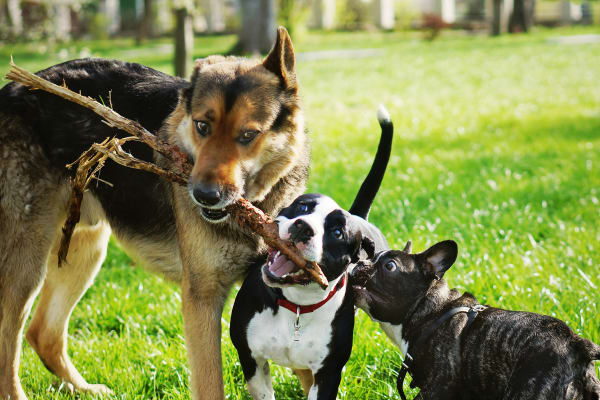Fun and Fascinating Dog Facts
Anatomy
A dog’s average body temperature should be right around 101.2 degrees Fahrenheit.
Contrary to what many people believe, dogs can see color, but not as vividly as us humans.
The number one health problem dogs deal with is obesity.
As omnivores, our four-legged friends need a well-rounded diet. They should eat more than just meat - they also need vegetables and proteins.
Dogs have an amazing sense of hearing - they are excellent guard dogs because they can hear sounds at high frequencies that their human friends can’t.
Because the only sweat glands a dog has are between his toes, it’s important to make sure your dog stays cool and hydrated in those dog days of summer. Give them plenty of shade and water, and keep them inside on very hot days.
Dogs’ sense of smell is around anywhere from 10,000 to 100,000 times better than peoples’. Their mind-blowing sense of smell means they can be trained as working dogs.
They are often used in airports and other environments to sniff out bombs, drugs and other illegal items. Their nose prints are also similar to our fingerprints, in that they are one-of-a-kind.
Communication
Our pups can’t talk, but they use different techniques to communicate with us. If your dog positions her body in a specific way, marks her scent, bares her teeth, barks or makes interesting facial expressions, you can bet she’s trying to tell (or other animals that may be around) something!
Domesticated Dog Origin
During the last several thousand years, we’ve gradually transformed dogs into the domesticated friends we know and love today. Dogs have been kept as pets for about 12,000 years.
Language
“Dog” is the English word for our canine friends. The word originated from the Middle English “dogge”, which stemmed from docga in Old English, meaning “a powerful dog breed”.
Dogs as Pets
While many people get a decade or more of joy out of keeping dogs as pets, many breeds are also known for and trained to be exceptional workers. They are trained to join military and law enforcement ranks, provide protection, track missing persons, pull loads, herd, hunt, help people with disabilities, and more.
Are you looking to add a canine companion to your family? Our veterinarians can help you learn about different breeds and mix breeds, common medical conditions with certain breeds, and how to set up a positive introduction to your home. Our veterinarians can also work alongside our recommended trainers to help you choose a wonderful new companion. Contact Us today.

Looking for a vet in Asheville?
We're always accepting new patients, so contact our veterinary hospital today to book your pet's first appointment.Related Articles View All
Your Guide to Cat Rabies Symptoms & Prevention
Rabies is not only fatal for cats, it can be passed from our feline friends to us! In today's post, you will learn how rabies is spread, what makes it so deadly, what symptoms to look for, and how rabies in cats can be prevented.
Tooth Resorption in Cats
Is your cat reluctant to eat, drooling or showing other unusual behaviors? If so, it could be due to painful tooth resorption. Our North Asheville vets explain the signs to watch for and how tooth resorption can be treated.
Inflammatory Bowel Disease in Dogs, Life Expectancy
At Animal Hospital of North Asheville our vets often treat dogs with inflammatory bowel disease (IBD), and while there is no cure for this condition, in many cases IBD can be managed successfully. Here we look at the prognosis for dogs suffering from IBD.
What is hip dysplasia in dogs? How is it treated?
Hip dysplasia is a condition characterized by the abnormal formation of one or both your dog's hips leading to pain when exercising or changing position. Here our North Asheville vets explain more about hip dysplasia, its symptoms and the surgeries used to treat this condition.
